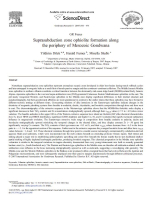Добрый день, Коллеги. Важное сообщение, просьба принять участие. Музей Ферсмана ищет помощь для реставрационных работ в помещении. Подробности по ссылке
Suprasubduction zone ophiolite formation along the periphery of Mesozoic Gondwana / Образование офиолитов в надсубдукционной зоне по периферии мезозойской Гондваны
Neotethyan suprasubduction zone ophiolites represent anomalous oceanic crust developed in older host basins during trench rollback cycles and later entrapped in orogenic belts as a result first of trench-passive margin and then continent–continent collisions. The Middle Jurassic Mirdita zone ophiolites in northern Albania constitute a critical transition between the dominantly mid-ocean ridge basalt (MORB)-related Early Jurassic Alpine–Apennine ophiolites in the west and supra-subduction zone (SSZ)-generated Cretaceous Eastern Mediterranean ophiolites in the east. The previously recognized Western- and Eastern-type ophiolites in the Mirdita zone display significant differences in their internal structure and pseudostratigraphy, but their geochemical affinities are more gradational in contrast to the earlier claims that these ophiolites may have formed in different tectonic settings at different times. Crosscutting relations of dike intrusions in the Eastern-type ophiolites indicate changes in the chemistry of magmatic plumbing systems from basaltic to andesitic, dacitic, rhyodacitic, and boninitic compositions through time and from west to east. The chemostratigraphy of the extrusive sequence in the Western-type ophiolites shows that the MORB-like tholeiitic rocks display a significant decrease in their TiO2 contents and Zr concentrations stratigraphically upward, although their εNd(T) values (+7.3 to +6.9) show minor variation. The basaltic andesites in the upper 100 m of the Western extrusive sequence have island arc tholeiite (IAT)-like chemical characteristics (low-Ti, lower HFSE and HREE distribution, significant LREE depletion and higher Co, Ni, and Cr contents) that signify increased subduction influence in magma/melt evolution. The Eastern-type extrusive rocks range in composition from basaltic andesite to andesite, dacite and rhyodacite stratigraphically upward mimicking the temporal changes in the sheeted dikes, and they display constant Zr (∼ 50 ppm) but significantly varying Cr contents. The TiO2 contents of their pyroxenes are b0.3 wt.%, and their εNd(T) values decrease from +6.5 in the lower parts to ∼ +3.1 in the uppermost section of the sequence. Farther east in the extrusive sequence the youngest boninitic lavas and dikes have εNd(T) values between −1.4 and −4.0. These chemical variations through time point to a mantle source increasingly contaminated by subduction-derived aqueous fluids and sediments, which were incorporated into the melt column beneath an extending protoarc–forearc region. Slab retreat and sinking played a major role in establishing asthenospheric upwelling and corner flow beneath the forearc mantle that in turn facilitated shallow partial melting of highly depleted harzburgitic peridotites, producing boninitic magmas. This chemical progression in the Mirdita zone ophiolite volcanism is similar to the temporal variations in magma chemistry documented from very young intraoceanic arcs built on recently generated backarc crust (i.e., South Sandwich arc). The Western and Eastern-type ophiolites in the Mirdita zone are therefore all subduction-related with the subduction zone influence in the lavas increasing stratigraphically upward as well as eastwards, suggesting a west-dipping slab geometry. The Mirdita zone and the Western Hellenic ophiolites in the Balkans were produced within a marginal basin that had evolved between the Apulian and Pelagonian microcontinents, and were subsequently emplaced onto their passive margins diachronously through different collisional processes.




